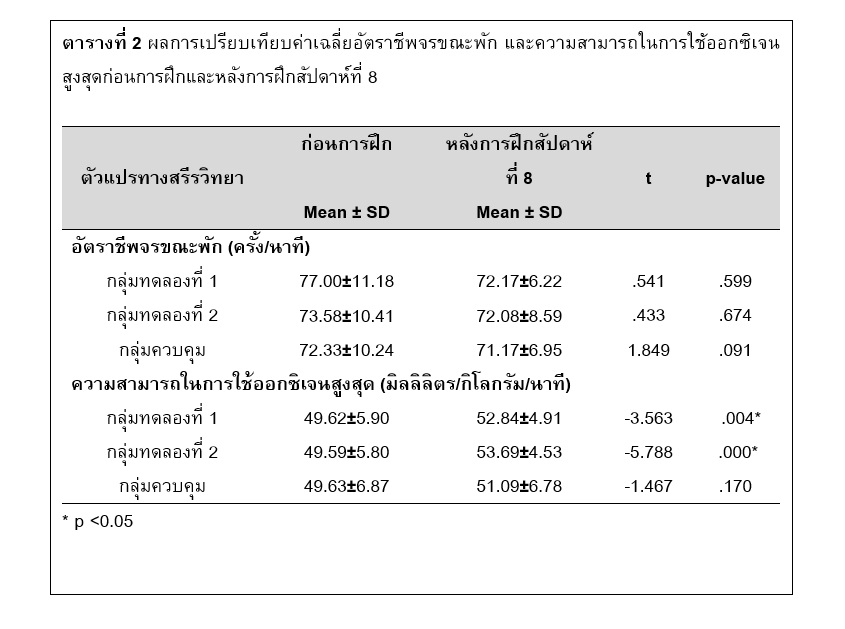THE EFFECTS OF SMALL-SIDED GAMES ON PHYSIOLOGICAL CHANGES IN YOUTH FUTSAL PLAYERS
Main Article Content
Abstract
Purpose
The purpose of this study was to examine the effect of small-side games using regulated heart rate on changes in physiological variables in youth futsal players.
Methods
A total of 36 futsal players, aged between 13-16 years, were recruited from the Angthong Sports School. The participants were randomized divided into 3 groups of 12 athletes. The first experimental group performed a normal small-side game, while the second experimental group underwent a small-side game with heart rate monitor. The control group received normal training program only. All participants trained for 8 weeks, 3 days per week and 45-65 minutes per day. Physiological variables included anaerobic performance, aerobic performance and body composition were measured before and after 8 weeks of training.Data were analyzed using One-way ANOVA followed by least square difference (LSD) and paired t-test for differences in dependent variables between groups and within group,respectively.
Results
Following an 8-week of training, anaerobic power, anaerobic capacity, maximum oxygen uptake and muscle mass were significantly increased in both experimental groups compared to prior training (p<.05). However, no significant differences in any variables were observed among the three groups (p>.05).
Conclusion
The present findings demonstrated that a small-side game practice with and without heart rate regulation over a 8 week period resulted in similar improvements in anaerobic power, anaerobic capacity,maximum oxygen uptake, and muscle mass in youth futsal players.
Article Details

This work is licensed under a Creative Commons Attribution-NonCommercial-NoDerivatives 4.0 International License.
References
Anek, A., and Peepathum, P., (2019). The effects of supramaximal high-intensity intermittent training on fat mass and lean mass in young male athletes.Journal of Sports Science and Health, 20(1), 13-27.
Barbero-Alvarez, J. C., D'ottavio, S., Granda-Vera, J., and Castagna, C. (2009).Aerobic fitness in futsal players of different competition level. Journal of Strength & Conditioning Research, 23(7), 2163-2166.
Barbero-Alvarez, J. C., Subiela, J. V., Granda- Vera, J., Castagna, C., Gomaz, M., and Del Coso, J. (2015). Aerobic fitness and performance in elite female futsal players. Biology of Sport, 32(4), 339-344.
Berdejo-del-Fresno, D., Moore, R., and Laupheimer, M. W. (2015). VO2max changes in English futsal players aftera 6-week period of specific small-sided games training. American Journal of Sports Science and Medicine, 3(2),28-34.
Boonprom, T. and Komaratut, C. (2009).Effects of leg muscle power training programs on anaerobic fitness in rugby football player. Journal of Sports Science and Health, 10(2), 55-66.
Boraczynski, T., and Urniaz, J. (2008). Changes in aerobic and anaerobic power indices in elite handball players following a 4-week general fitness mesocycle. Journal of Human Kinetics,19(1), 131-140.
Boutcher, S. H. (2011). High-intensity intermittent exercise and fat loss.Journal of obesity,
Castagna, C., D'Ottavio, S., Grada-Vera, J., and Barbero-Alvarez, J. C. (2009).Match demands of professional futsal: A case study. Journal of Science and Medicine in Sport, 12(4), 490-494.
Chootsungnoen, P., Makaje, N. and Rungthai, R. (2014). Physiological responses and technical skills during 3 vs 3 smallsided games with different protocol in futsal players. Journal of Sports Science and Technology, 14(2), 65-73.
Cohen, J. (1988). Statistical power analysis for the behavioral sciences (2nd ed.). New Jersey: Lawrence Erlbaum Associates, Publishers.
Draper, P. N., and Whyte, G. (1997). Anaerobic performance testing. Peak Performance, 87, 7-9.
Hammami, A., Gabbett, T. J., Slimani, M., and Bouhlel, E. (2018). Does small-sided games training improve physical-fitness
and specific skills for team sports?A systematic review with meta-analysis. Journal of Sports Medicine and Physical Fitness, 58(10), 1446-1455.
Leger, L. A., Mercier, D., Gadoury, C., and Lambert, J. (1988). The multistage 20 metre shuttle run test for aerobic fitness. Journal of Sports Sciences, 6(2),93-101.
Luesopha, P. and Yimlamai, T. (2019). Effects of speed endurance training on aerobic and anaerobic capacity in collegiate male football players. Journal of Sports Science and Health, 20(3), 15-26.
Makaje, N., Ruangthai, R., Arkarapanthu, A.,& Yoopat, P. (2012). Physiological demands and activity profiles during futsal match play according to competitive level. Journal of Sports Medicine and Physical Fitness , 52(4), 366.
Rabbani, A., Clemente, F. M., Kargarfard, M.,and Jahangiri, S. (2019). Combined small-sided game and high-intensity interval training in soccer players: The effect of exercise order. Journal of Human Kinetics, 69, 249.
Rave, G., Granacher, U., Boullosa, D., Hackney, A. C., and Zouhal, H. (2020). How to use global positioning systems (GPS) data to monitor training load in the “Real World” of elite soccer. Frontiers in Physiology, 11, 944.
Rouengsuksud, B., Thanaponganan, N. and Tanoommek, A. (2017). Effect of rest interval training to anaerobic performance endurance and speed in male student. Journal of Educational Administration and Supervisor, Mahasarakham University, 8(3), 104-115.
Wongdontree, K. (2015). Effect of low volume high intensity interval training on body weight and physical fitness of wrestlers. Master’s Thesis, Major Exercise and Sport Science, Faculty of Sport Science, Burapha University, Thailand.


